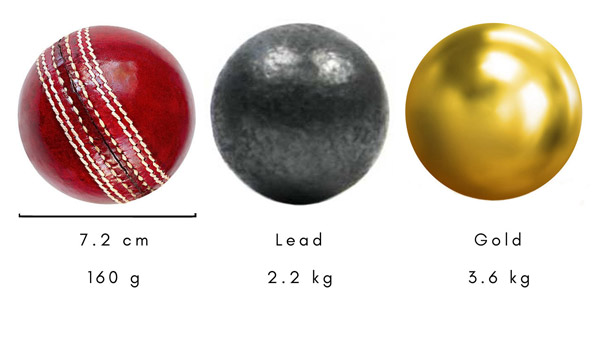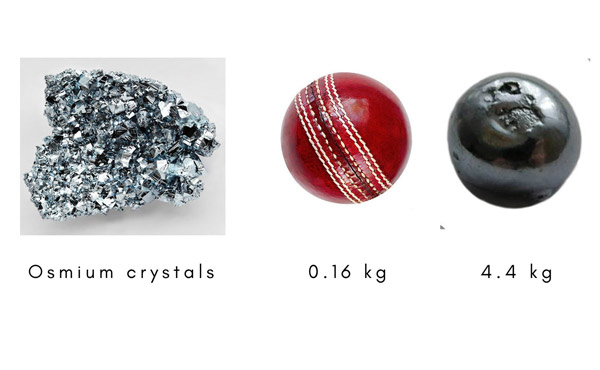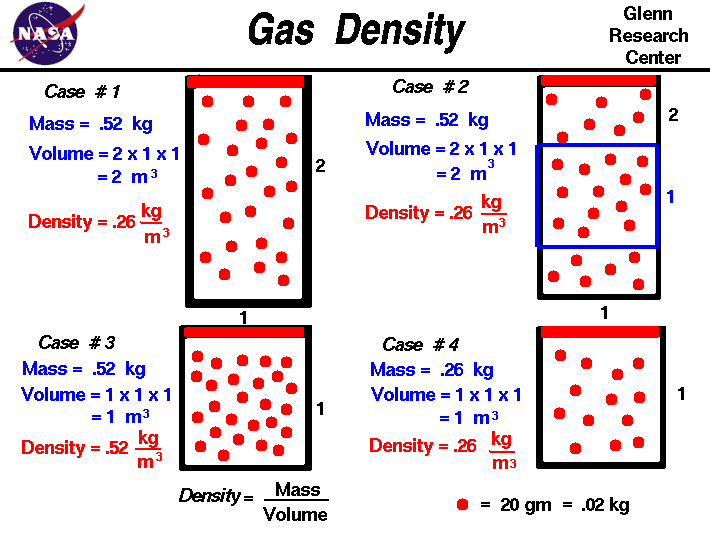density

Figure 1. The density of lead and gold is illustrated by the mass of balls of these metals the same size a sa cricket ball.

Figure 2. Osmium is the densest element.

Density is the ratio of the mass of a substance or object to its volume. Substances that are light for their size have a low density, and vice versa. Objects whose density is less than that of water will float in water, while a hot air balloon will rise when its average density becomes less than that of air. In the metric system, density is measured in grams per cubic centimeter (or kilograms per liter).
The term is also applied to properties other than mass; e.g., charge density refers to the ratio of electric charge to volume.
| Densities of familiar substances and objects | |
|---|---|
| object / substance | density (g/cm3) |
| water | 1.0 |
| iron | 7.89 |
| Sun | 1.41 |
| white dwarf | 2 × 106 |
| neutron star | 7 × 1014 |
| Venus | 5.2 |
| Earth | 5.52 |
| Mars | 3.94 |
| Jupiter | 1.31 |
| Saturn | 0.69 |
| Uranus | 1.29 |
| Neptune | 1.64 |
| Pluto | 2.03 |
The densest element
"As heavy as lead." It's a common expression and it's true – lead is heavy for its size. A cricket ball weighs about 160 grams and has a radius of about 3.6 cm. A solid ball of lead the same size would weigh 2.2 kilograms. Swap the lead for gold, though, and the ball would be more than half as heavy again at close to 3.8 kilograms (Figure 1).
Dividing an object's mass by its volume tells you its density. The density of lead is 11.3 grams per cubic centimeter (gr/cm3), that of gold 19.4 g/cm3. Denser still are a handful of other elements, including tungsten and platinum. But densest of all is a precious metal that's much rarer than either gold or platinum: element 76, osmium. A cricket ball made of osmium would weigh about 4.4 kilograms – slightly more than a women's shot put. No substance on Earth has a greater density (Figure 2).
Everything around us is composed of atoms. An atom of osmium, for instance, consists of a nucleus containing 76 protons and (most commonly) 116 neutrons around which circulates a cloud of 76 electrons. Only the nucleus is substantial, accounting for almost all the atom's mass. And yet the nucleus is tiny compared with the atom as a whole. An osmium nucleus has a radius of just 7.2 × 10–15 meter, or 7.2 picometers. That's about 25,000 times less than the radius of an osmium atom, equivalent to an atom-to-nucleus volume ratio of about 15 trillion.
Why does osmium have a higher density than the element with the heaviest nucleus found in nature, uranium, and even heavier elements that have been made artificially? The reason is that an osmium atom is relatively small in relation to the mass of its nucleus because the outermost electrons are pulled in tightly, resulting in an overall compact size.
Most of an atom is empty space. So, what outwardly may seem like a hard, solid object, such as a rock or an iron bar, is really almost ghostlike in its internal emptiness. Despite that, it’s very difficult to make something that's solid any denser by squeezing it because atoms are formidably strong and rigid. Even the immense pressures found deep within a planet can only compress solid matter to a modest degree.
The density of matter in stars
Stars, on the other hand, are much massive than planets so that their deep interiors are squeezed much harder by the great weight of the overlying layers. The pressure at the cent er of the Sun is about 265 billion times greater than the atmospheric pressure at Earth's surface. What's more the Sun's core is extremely hot – about 15 million degrees Celsius. At this temperature, atoms are stripped of all their electrons, leaving behind bare nuclei. The hot soup of free electrons and naked nuclei is known as a plasma – a fourth state of matter that is different from solid, liquid or gas.
Because the atomic structure has been broken down in a plasma, it's possible to squash the constituent electrons and nuclei much closer together than would be the case with ordinary matter, resulting in a higher density. This is true even though the nuclei present in the core of most stars, such as the Sun, are those of the lightest elements, hydrogen and helium. The density in the Sun's core is estimated to be as high as 160 g/cm3 – seven times higher than the density of osmium. A cricket ball made of hot plasma scooped from the center of the Sun would weigh about 31 kilograms.
Degenerate matter
In the distant future, the density deep inside the Sun will rise further. At some point, several billion years from now, all the hydrogen in the Sun's core will have been converted into helium by nuclear fusion. To begin with, this helium won't be hot enough to itself fuse into heavier elements. Instead, it will be squeezed harder and harder by the weight of the overlying layers, causing its density to soar to about 10 million grams – 10 metric tons – per cubic centimeter. Only then will another force come into play that prevents further compression. The electrons in the compressed helium plasma will resist being pushed closer together by a phenomenon called the Pauli exclusion principle. According to this principle, no two neighboring electrons can be in exactly the same state as defined by four special quantities known as quantum numbers.
Matter that's so squashed the exclusion principle resists further compression is said to be "degenerate". Later in their evolutionary journey, Sun-like stars grow to become red giants before casting off their bloated outer layers to leave behind hot, planet-sized white dwarfs. These exposed stellar cores are made entirely of degenerate matter, doomed to cool for eternity, but supported against further gravitational implosion by the pressure of electrons resisting further overcrowding.
The Sun is a very ordinary star, which just looks spectacularly big and bright because it's so close. Many stars are bigger, brighter, and, more to the point, more massive than the Sun. Their endpoints are correspondingly more extreme. A star much heavier than the Sun explodes violently at the end of its life leaving behind a core that can't stabilize as a white dwarf. Instead if the remnant core weighs more than about 1.4 times as much as the Sun, electron degeneracy isn't enough to prevent the core from collapsing further under the force of its own gravity. Electrons and protons are crammed together so hard they combine to become neutrons, giving rise to a miniature but massive stellar core known as a neutron star.
Imagine the mass of one-and-a-half Suns crammed into a ball that's only about 15 kilometers wide. The stuff of which it's made is neutronium – an ultra-dense form of matter in which neutrons, perhaps with a few protons and electrons sprinkled here and there, are packed tightly together. A neutronium cricket ball would weigh about 200 billion metric tons, or roughly the same as Mount Everest. The only thing stopping a neutron star from squeezing itself even smaller is neutron degeneracy due to the exclusion principle acting on closely packed neutrons.
Conceivably, there's a more dense state that may exist in the cores of some neutron stars. If the temperature and pressure in the heart of a neutron star are high enough, it's been hypothesised, the degeneracy pressure of the neutrons might be overcome. If this were to happen the neutrons would be forced to merge and break apart into quarks – the building blocks of particles such as protons and neutrons. This would lead to an ultra-dense phase of matter called quark matter. It's an open question whether quark matter and quark stars exist in the universe today.

